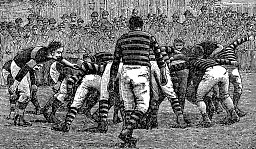Milnerton Rugby Ground and the Suburb of Rugby
In 1905, before the first Springbok rugby team had been selected, the Western Province Rugby Union acquired 13 acres of land, to be laid out as a rugby football ground in Milnerton.
 |
| An early game of rugby |
Though now taken for granted, there was an innovation in the instruction to the engineer “to lose no time in the preparation of the surface and to get all possible information as to the best means of fertilising the soil for the purpose of growing grass, and generally to leave no stone unturned” – a delightful expression – “to make the field a success”. Such was the advent in South Africa, at a cost of £340, of rugby played on specially planted turf. Cocksfoot grass, mixed with Kweek grass, was the formula strongly recommended by Mr Ayres, the nurseryman. Early in February 1906, the formal agreement was finally ratified at the General Meeting of the Western Province Rugby Union.
 |
| The Rugby Ground was the area to the right of Rugby Station (centre) |
During May 1907, a Mr Smuts wrote to Milnerton Estates, enquiring “whether the directors would favour holding Coloured [sic] football matches on the Football Union’s ground”, giving as a reason that, while the Western Province Rugby Union had no direct interest in the matter, he would use his influence to persuade the Coloured Rugby Union to play there. In addition, he suggested that the Milnerton Estates spend £30 on the erection of a corrugated iron shed as a changing room. Startled at the novelty of the idea, the Board asked for further particulars, including the days on which the Coloured Union usually held their matches. Having ascertained that they would take place on Saturdays, the Company gave its approval, “provided that the Rugby Union is satisfied that the playing of Coloured matches and Union matches on the same ground at the same time will not be taken exception to.”
 |
| A rugby game in 1906 |
During the late 1950s, the Cape School Board acquired the Milnerton Rugby Ground, and Zonnekus (now Woodbridge) Primary School was built on the site. The story of Union-Milnerton Rugby Club will be told in a later blog.
 |
| Woodbridge Primary School (formerly Zonnekus Primary School), situated on the old Rugby Ground |
In the mid-1920s, Milnerton Estates received a
proposal from Mr AW Koenig, who owned an area of land on the Cape Town side of
the rugby ground, then known as Rugbyville. Though actually a hotelkeeper, he
aspired to create a new township, which he hoped would become part of Milnerton
Estates. The price he asked was very reasonable: £5,000 for 1,000 plots, so the
Company succumbed to the temptation. The basic selling price for a plot of
5,000 square feet was fixed at £25 with those on corners slightly higher. A
policy of tree-planting was promptly commenced there, particularly eucalyptus.
One of the first applicants for land after this
transaction was the well-known pioneer storekeeper, Charles Greig, already
living there, who wanted to erect an interdenominational place of worship.
While the Company accepted the idea, its realisation was postponed.
During the 1960s, first the Italian Club and then the Portuguese Club acquired land in Rugby, where they built their club houses and laid out football fields. Large crowds would gather on Sunday afternoons to watch the local "International" matches.
 |
| The Italian and Portuguese Clubs (Courtesy Google maps) |
Though once considered a suburb predominantly for blue-collar workers and their families, Rugby (as it is now known) has recently begun to attract more affluent residents.




Comments
Post a Comment